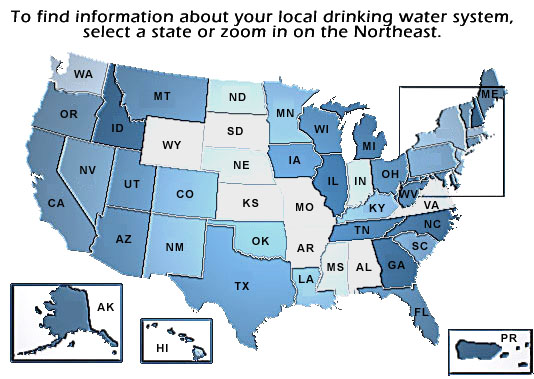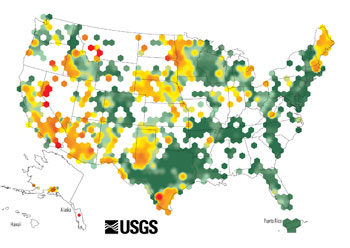
Information, Tests and Solutions to Improve Your Health and Water Quality. |
||||||||||||
Chloramine Toxicity -
|
|
Eye irritation |
Bladder cancer |
|
Nose irritation |
Asthma |
|
Lung irritation |
Anemia |
|
Pharynyx irritation |
|
|
Weakended immune system |
|
|
Stomach discomfort |
Even though Chloramine toxicity may be a concern, disinfecting tap water is critical to protect the public from disease-causing microorganisms. Chlorine has been the most commonly used disinfectant. Drinking water is disinfected to kill bacteria, viruses, and other organisms that cause serious illnesses and deaths. Disinfection of drinking water has benefited public health enormously by lowering the rates of infectious diseases (for example, typhoid, hepatitis and cholera) spread through untreated water. In the beginning of the last century, prior to the disinfection of drinking water, tens of thousands of people died from disease-causing microorganisms in the water supply.
Chloramine is also used as a disinfectant used to treat drinking water. It is formed by mixing chlorine with ammonia. Although it is a weaker disinfectant than chlorine, it is more stable which extends its disinfectant benefits throughout a water utility's distribution system (a system of pipes that delivers water to homes).
Chloramine toxicity can occur because chloramine levels are more complicated to regulate than chlorine levels. Failure to properly control and monitor the treatment process can cause undesirable chemical reactions such as increased corrosion of pipes or nitrification in the distribution system.
Corrosion can cause leaching of lead and copper from pipes and solder. Nitrification can cause a loss of disinfectant residual. Proper operation and management of the treatment system and disinfectant levels prevents these potential drawbacks to the use of chloramines.
Maintaining a pH level of 7.2 to 7.8 is necessary to control the formation of dichloramine and trichloramine.[6] [7] Dichloramine and trichloramine are more toxic and have a greater tendency to breakdown into toxic disinfection by-products (DBPs). If your water pH is less than 7.2 or greater than 7.8 your water may form DBPs.
Lead and
Copper
Plumbing installed prior to 1988
typically has solder that contains up to 50% lead. There are two ways in which the use of chloramine can
indirectly affect corrosion of lead in solder and copper pipes.
First, when chloramine is used in water treatment as a residual disinfectant, it can change the chemical properties of the water, which subsequently can impact lead and copper corrosion. Certain conditions related to pH, alkalinity, and dissolved inorganic carbonate levels in the water can cause lead to dissolve from pipe material.
Second, chloramination, if not properly optimized, can result in nitrification (conversion of ammonia into nitrite and then nitrate) in the presence of bacteria. Nitrification can lower the pH of the water, which can increase corrosion of lead and copper. Elevated water levels of copper and lead cause elevated blood levels in the families drinking and bathing in the water.[8] [9] Increasing chlorine levels from 1.0 to 2.0 ppm nearly doubled lead concentrations from about 100 to nearly 200 ppb.[10] Chloramine has also been shown to cause lead to dissolve by preventing normal protective layers of film from forming inside plumbing.[11] [12]
When the water company serving the Washington D.C area switched to chloramines they soon found lead levels 3,200 times greater than the EPA's action level. Things were so bad, according to the Washington Post, the water company withheld reporting some of their water test results and simply told their customers their water was fine. That same newspaper reported, "Cities across the country are manipulating the results tests used to detect lead in water, violating federal law, and putting millions of Americans at risk."[13]
In some systems using chloramines, brass in plastic plumbing systems might be more susceptible to lead/copper leaching, and accelerated dezincification, due to lower pH values resulting from nitrification.[14] Brass alloys in connections, valves and faucets contain copper, zinc and up to eight percent lead
Adding fluoride to the chlorine water increased lead concentrations to over 900 ppb. Lead concentrations in chloramine with fluoride water continue to increase with time.[15]
Swimming Pools and Hot Tubs
Chloramines in and just above the water of pools are known to irritate the eyes, nose and pharynx and may precipitate an asthma attack and lung irritation.[16] [17] [18] [19] Swimming-pool asthma due to airborne nitrogen trichloride can occur in workers who do not enter the water because of this chloramine. The air above indoor swimming pools therefore needs to be assessed and managed as carefully as the water.[20]
Dental and Mercury Amalgams
Chloramine and chlorine releases mercury from dental amalgams.[21]
Cancer
Long term exposure to chlorinated surface water increases the risk of bladder cancer.[22]
Chlorine and react with naturally occurring chemicals in the water and form disinfection by-products (DBPs) and
trihalomethanes (THMs). The increase risk of bladder cancer is associated with trihalomethane (THM) levels,
showering/bathing/swimming (i.e., dermal/inhalation exposure) and having the GSTT1-1 gene. THMs or other DBPs
and genetics increase the risk of bathing and drinking water associated bladder cancer.[23]
[24]
Another study showed that THMs were carcinogenic in the liver, kidney, and/or intestine of rodents. There was equivocal evidence for carcinogenicity in female rats that received chlorinated or chloraminated (chloramine) drinking water; this evidence was based on a marginal increase in the incidence of mononuclear cell leukemia. The study results suggest that organic byproducts of chlorination are the chemicals of greatest concern in assessment of the carcinogenic potential of chlorinated drinking water.[25]
Immune System
A slight excess of deaths from pneumonia and influenza was observed in communities whose residents drank and bathed in chloraminated water compared to residents from chlorinated communities, as well as to all Massachusetts residents.[26]
Removing Chloramine
Researchers state "activated charcoal chemically destroys chloramine. Small charcoal particle size, quantity of charcoal, low water volume, and low temperature enhances the effectiveness of activated charcoal filters."[27] (I added the bold and highlighted emphasis.)
According to NSF water filter systems certified for reduction of chlorine will not automatically be effective for chloramines as well. You should ensure the system you select is certified specifically for reduction of chloramines. The NSF/ANSI Standard 42 is the only approved filtration for chloramine. Standard 42 uses carbon/charcoal filters.[28]
You should test your water before and after filtering. Make sure your water filter system is removing chloramine and chlorine. WaterWorks2 (Free Chlorine and Total Chlorine Test Strips) are available in our office.
Extensive information about Chloramine Toxicity is available at Citizens Concerned About Chloramine (CCAC).
How to test your water for Chloramine Toxicity: Chlorine Water Test
Return from Chloramine Toxicity to Water Quality and Toxicities.
[1] http://www.epa.gov/safewater/contaminants/index.html
[2] Case-control study of bladder cancer and water disinfection methods in Colorado . McGeehin MA, Reif JS, Becher JC, Mangione EJ. Am J Epidemiol. 1993 Oct 1;138(7):492-501.
[3] Type of disinfectant in drinking water and patterns of mortality in Massachusetts . Zierler S, Danley RA, Feingold L. Environ Health Perspect. 1986 Nov;69:275-9.
[4] Plumbing the depths of D.C.'s drinking water crisis. Renner R. Environ Sci Technol. 2004 Jun 15;38(12):224A-227A.
[5] http://www.epa.gov/safewater/disinfection/chloramine/index.html
[6] http://www.depweb.state.pa.us/watersupply/cwp/view.asp?a=1251&q=504451
[7] http://www.epa.gov/safewater/disinfection/chloramine/index.html
[8] http://www.epa.gov/safewater/disinfection/chloramine/index.html
[9] Changes in blood lead levels associated with use of chloramines in water treatment systems. Miranda ML, Kim D, Hull AP, Paul CJ, Galeano MA. Environ Health Perspect. 2007 Feb;115(2):221-5.
[10] Effects of fluoridation and disinfection agent combinations on lead leaching from leaded-brass parts. Maas RP, Patch SC , Christian AM, Coplan MJ. Neurotoxicology . 2007 Sep;28(5):1023-31
[11] Electrochemistry of free chlorine and monochloramine and its relevance to the presence of Pb in drinking water. Rajasekharan VV, Clark BN, Boonsalee S, Switzer JA. Environ Sci Technol. 2007 Jun 15;41(12):4252-7.
[12] Evidence that monochloramine disinfectant could lead to elevated Pb levels in drinking water. Switzer JA, Rajasekharan VV, Boonsalee S, Kulp EA, Bohannan EW. Environ Sci Technol. 2006 May 15;40(10):3384-7.
[13] Plumbing the depths of D.C.'s drinking water crisis. Renner R. Environ Sci Technol. 2004 Jun 15;38(12):224A-227A.
[14] Nitrification in premise plumbing: role of phosphate, pH, and pipe corrosion. Zhang Y, Griffin A, Edwards M. Environ Sci Technol. 2008 Jun 15;42(12):4280-4.
[15] Effects of fluoridation and disinfection agent combinations on lead leaching from leaded-brass parts. Maas RP, Patch SC , Christian AM, Coplan MJ. Neurotoxicology . 2007 Sep;28(5):1023-31
[16] Scottish Centre for Infection and Environmental Health. http://www.documents.hps.scot.nhs.uk/environmental/chemicals-in-drinking-water/chloramines.pdf
[17] Ocular and respiratory illness associated with an indoor swimming pool--Nebraska , 2006. Centers for Disease Control and Prevention (CDC). MMWR Morb Mortal Wkly Rep. 2007 Sep 14;56(36):929-32.
[18] Outbreaks of short-incubation ocular and respiratory illness following exposure to indoor swimming pools. Bowen AB, Kile JC, Otto C, Kazerouni N, Austin C, Blount BC, Wong HN, Beach MJ, Fry AM. Environ Health Perspect. 2007 Feb;115(2):267-71
[19] The determinants of prevalence of health complaints among young competitive swimmers. Lévesque B, Duchesne JF, Gingras S, Lavoie R, Prud'Homme D, Bernard E, Boulet LP, Ernst P. Int Arch Occup Environ Health. 2006 Oct;80(1):32-9
[20] Occupational asthma caused by chloramines in indoor swimming-pool air. Thickett KM, McCoach JS, Gerber JM, Sadhra S, Burge PS. Eur Respir J. 2002 May;19(5):827-32.
[21] Comparison of chlorine and chloramine in the release of mercury from dental amalgam. Stone ME, Scott JW, Schultz ST, Berry DL, Wilcoxon M, Piwoni M, Panno B, Bordson G. Sci Total Environ. 2009 Jan 1;407(2):770-5.
[22] Case-control study of bladder cancer and water disinfection methods in Colorado . McGeehin MA, Reif JS, Becher JC, Mangione EJ. Am J Epidemiol. 1993 Oct 1;138(7):492-501.
[23] Occurrence, genotoxicity, and carcinogenicity of regulated and emerging disinfection by-products in drinking water: a review and roadmap for research. Richardson SD , Plewa MJ, Wagner ED, Schoeny R, Demarini DM. Mutat Res. 2007 Nov-Dec;636(1-3):178-242
[24] An evaluation of the role of epidemiology in assessing current and future disinfection technologies for drinking water. Neutra RR, Ostro B. Sci Total Environ. 1992 Dec 15;127(1-2):91-122; discussion 122-35.
[25] Assessment of the carcinogenic potential of chlorinated water: experimental studies of chlorine, chloramine, and trihalomethanes. Dunnick JK, Melnick RL. J Natl Cancer Inst. 1993 May 19;85(10):817-22.
[26] Type of disinfectant in drinking water and patterns of mortality in Massachusetts . Zierler S, Danley RA, Feingold L. Environ Health Perspect. 1986 Nov;69:275-9.
[27] [Reducing chloramines in drinking water] Becker FF, Janowsky U, Overath H, Stetter D. Biomed Tech (Berl). 1989 Nov;34(11):280-8.
[28] http://www.nsf.org/consumer/drinking_water/contaminant_chloramine.asp?program=WaterTre
Quality Water Testing and Analysis for Residential and Commercial Water Sources
My Mission
Provide you with accurate information, economical and
effective tests
and products to evaluate your body and water for toxic metals and remove them if
necessary.
Keith D. Bishop
Clinical Nutritionist
B.Sc. Pharmacy
Health Coach©

*These statements have not been evaluated by the Food and Drug Administration. These products are
not intended to diagnose, treat, cure or prevent any disease.
The information and contents of this website are based upon government, medical,
university and health industry research information.
Consult with your physician or a qualified health care provider before making any changes in your medical or
treatment program.
Please let us know if you have problems viewing anything or ordering on this page:
Thank you for visiting www.ToxicWaterSolution.com! If you find this information helpful or
interesting please send a link to your family and friends.
Copyright © 2007-2014 Natural Care Solution, LLC Keith D. Bishop, Clinical Nutritionist, B.Sc. Pharmacy
 Potential chloramine toxicity and chlorine
toxicity symptoms include include:
Potential chloramine toxicity and chlorine
toxicity symptoms include include: 





